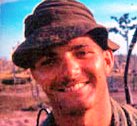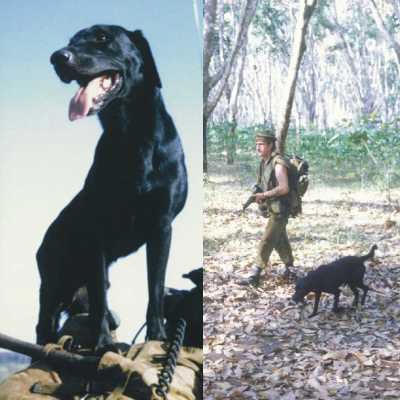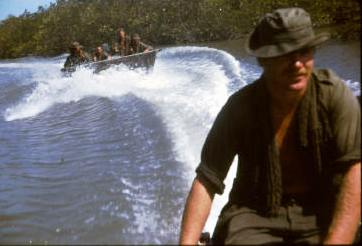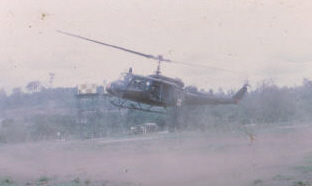With the equivalent of three tours under their collars they were real veterans of the Vietnam war. Like other veterans they had little choice about where and when they deployed. Like other veterans they did their job as best they could under very trying conditions. Like other veterans they usually got good results but occasionally had bad days. 'They' were the Labrador tracker dogs with the ANZAC battalion's Trackers and Anti-Tank Platoon. Do they have a story..? You bet, and the ending of their story is similar to the ending experienced by most other veterans. In total eleven Australian tracker dogs were deployed to Vietnam. Two dogs were routinely assigned to each of the Australian battalions based at the Task Force base at Nui Dat. A typical tracker team consisted of two dogs with handlers, two visual trackers, a machine-gunner and a radio operator [see picture]. The team operated on standby from Nui Dat, usually deployed by helicopter after a contact to follow up enemy trails or to locate suspected enemy positions. Once deployed, the dog would be put to a scent and start the track, usually at speed, until he would stop with nose or paw extended in a ‘point’ toward the suspected hideout. The tracker and dog would then fall back while the rest of the section swept the area, often locating wounded enemy or recently occupied positions. The deployment of tracker dogs in Vietnam was a success with the dogs considered highly competent at combat tasks. As well as locating enemy personnel and their support systems, the dogs were also thought to have on occasions saved the lives of their human companions. Dog handler Peter Haran is quoted about his dog: Caesar … could see, smell and hear Charlie long before we walked into a firefight. He knew where the mines were, where the trip wires were strung, and he could cover ground chasing the enemy at speeds which literally took your breath away. Milo and Trojan were assigned to the three ANZAC battalions 6, 2
and 4 RAR/NZ
ANZAC between 1968 and 1971, the dogs required to do a 3-year tour before being rested. Milo began his working life as a
war dog at 10 months of age and knew no other way of life. He was very photogenic
and friendly [with many photos - see links
below].
But why the interest in tracker dogs, since W3 Coy worked operationally with the tracker dogs on perhaps only one occasion in their tour. Unfortunately that occasion ended tragically and the dog, in many veterans minds, contributed to the accident. Milo was the dog present on 10 October 1970 when 3Pl had a fatal 'blue on blue' encounter. While with the platoon Milo had 'pointed' to several locations which required 3Pl to spend time and effort to sweep through and check. Platoon members believe that the tension caused by these sweeps contributed to the accident, with the death of Pte Cooper and the wounding of three other colleagues. [The 10 October 1970 accident has been researched in detail, see this article]. Milo and Pte Ron Johnson handler, with 2RAR tracker dog patrol 1970 [2RAR History] But is it fair to blame a tracker dog when things go wrong..? [The research found that the dog was not tracking being located behind the sweep section when the accident happened]. The dog did not point a weapon. The dog did not give a fire order. The dog just did its job. It was surely better for the dog to fail in a positive way [warn of VC] than to fail in a negative way [miss real VC, as happened to 8Pl C Coy on 8 October 1970]. This may not be a popular statement but these animals surely deserve the same courtesy and care of memory expected by other veterans. Agree..? 'I Was There' - add a comment Australia’s Vietnam war dogs never returned home, quarantine costs over a serious parasite problem which caused massive bleeding cited as the reason. After the
matter was raised in the Haran is again quoted: [the dogs] … had been forgotten as a soldier, and soldiers should not be forgotten in war; there should be some sort of memory of them. Many ex-handlers shared this feeling, and a permanent memorial to the dogs, the Australian War Dog Memorial, complete with carved statue and a drinking trough for dogs, was unveiled at a ceremony on the Alexandra Headland, on the Sunshine Coast, Queensland, in April 2001 Milo montage, courtesy of Australian websites There is more on the tracker teams and their dogs at these websites:
http://www.anzacday.org.au/history/vietnam/dogs.html |
| Tiptoe through the
Minefield - Bruce Young
I heard a commotion coming from the back of the vehicle, laughing Ross Cherry safely located in the middle of the AMC [Young]
|
|
The Long Son Boating Incident - [Admiral] Bob Upton
W3 Company had been on
Long Son Island for a period of time
protecting some Australian Every day we deployed a section plus to look after the Engineers on the pipeline task and did a little bit of local area patrolling with the rest. One day without any warning a helicopter landed at RHONDA and out got the Task Force Commander. He berated me about the amount of VC activity that was going on in the swamp areas around the island. This was news to me but being an inexperienced junior officer I replied “Yes sir”. He told me to get the Engineers to organise some boats and for us to get out there and find the ‘bastards’. Lt Bob Upton - 2Pl The next day two engineer bridging pontoons with an outboard motor fitted arrived, each crewed by two Australian engineers, to transport us on this mission. Neither pontoon had a ‘splash board’ fitted to the rather blunt and very low bow [required for operating as a boat rather than a pontoon] and no life jackets were available. After about 10 minutes of ‘orientation training’ we set off on the task. About six of the Platoon were in each boat but we only had one 77 radio set between the two boats. We boated down the main waterways through the mangrove swamps looking out for the enemy hordes. What the hell we would have done if we had come under heavy fire I don’t know. While checking out small inlets we found some equipment - in hindsight probably ‘deserted’ local fishing gear. What initially started out to be something different soon became very boring. As I remember it, after lunch we did locate a local acting in a suspicious manner and with no ID. I told the other boat to take the ‘suspect’ back to the police station in Long Son Village and then return. We carried on searching the water ways and inlets. Just as we entered a large inlet we observed a motorised junk. They saw us at the same moment and accelerated towards us throwing up a large bow wave. For some unknown reason, the young Engineer driving our boat throttled back on the engine causing the nose of our boat to drop just as the junks bow wave hit us. In a second our boat was
upside down and we were all in the water. Personally I remember sinking down under the weight of my webbing etc. I
let my webbing and M16 go but I still could not swim back up. I then realised that the fishing net we had found earlier
was caught in the metal clips on my boots and as the net sunk further I was being pulled down. Everything started going
a lovely peaceful blue colour and I clearly remember thinking I am going to
drown. I told myself “Infantry officers don’t die on active service by drowning, they get shot”. Somehow I managed to release the net from the boot clips and
swam for the surface but
Once on land we turned the boat over but could not re-start the outboard motor. Shortly after the other boat returned and they towed us back. Walking up the track from the water edge to RHONDA without boots and weapons felt very strange. I remember thinking about those photos we had seen of American POWs minus their weapons and footwear being escorted by the NVA to the prison camps in North Vietnam. The next morning we were flown back to Nui Dat to be re-equipped. I had to go and see the Battalion 2IC, Major Roy Taylor. He was very good about the whole episode and just pleased that we had lost no one. I was just about to leave Roy Taylor’s tent when the CO (John Church) appeared on the scene. He went ‘ballistic’ and told me how incompetent I was. Roy Taylor managed to appease him and off he stalked. I then learnt that Church was simply upset because the 77 set we had lost was actually an Australian set on loan to us. I can only surmise that Church was more concerned about equipment being lost than the lives of his soldiers. Later that day, with new weapons, boots and personal equipment we rejoined the platoon on Long Son Island. Perhaps not surprisingly we were never tasked again to do boat patrols around the island. PS: Some of you may remember that the day before we left Vietnam a helicopter carrying Church on a recon was shot down in the vicinity of Long Son Island – poetic justice I say.
Les
Ngawhare
on another Long Son patrol |
This article is written with respect for the helicopter pilots and crews who flew the dedicated casualty evacuation [CASEVAC] helicopters in support of any grunts injured on the ground. While any helicopter could generally evacuate injured soldiers, at times the circumstances were so difficult that the services of a specially equipped medical helicopter [known as DUSTOFF] were required. The article is based on my recollections and further detail is invited. On 29 May 1970 John Gurnick tripped a booby trap
and he and Chris Kennedy were seriously wounded. The site
was in tall timber under a rock face above a VC camp with no clearings nearby so extraction would need to be by helicopter winch. 3Pl called for a CASEVAC
and an Australian helicopter working in the area was diverted for the task. The helicopter was not fitted with a winch so
a second [Australian] helicopter with winch was tasked. The second helicopter pilot declined to use the winch as it
would have required a lengthy hover above the scene and rumour at
the time said the pilot was worried the area was 'hot' [meaning the VC might be in
range], although lack of fuel might also have been a factor. He apparently wanted Gurnick moved to a clearing but this was impracticable under the circumstances
so he was waved away and a third
helicopter requested. This helicopter was a US DUSTOFF model based at Nui Dat
and on arrival it dropped a jungle
penetrator [in appearance a giant bomb with foldout fins for casualties to sit on]
and Gurnick
and Kennedy were pulled out of the trees and
into the helicopter. 3Pl HQ asked the pilot which medical facility Gurnick would be taken to, to be told that he had
died in the helicopter. Both the death of Gurnick and the poor response by the Australian helicopter pilots impacted badly on W3 morale and there were mutterings about gutless helicopter crews not looking out for the grunts. To redress this once we had returned to Nui Dat in mid-June someone arranged for the company to attend a DUSTOFF demonstration at Eagle Farm LZ. US DUSTOFF landing at Eagle Farm to meet the company I remember we assembled on the side of the pad
and waited for something to
happen. Without warning a US DUSTOFF UH1 helicopter flew over the trees
and slammed down on the pad in front of us. While
the rotors were still turning the pilot leapt out and strode over to where we were gathered. He introduced himself
and said
he had heard we were worried about CASEVAC. We had a brief bitch session
and then the pilot took over. He stated he
was on temporary duty in III Corps from I Corps near the DMZ, because he had been in SVN seven months
and had already been shot
down and crashed twice while doing DUSTOFF. He was on his 3rd loadmaster [who worked the winch] because the others had
been killed or wounded. He showed us the .38 pistol he carried for self protection AFTER he crashes,
and the body armour
[he called it 'chicken vest'] with SARBE search and rescue locator beacon strapped to it which allowed him to talk to any rescue helicopters. As
the DUSTOFF helicopters wore the Red Cross symbol they were required to be unarmed but did have helicopter gunship support.
I remember he stated the gun ships were only useful after he started taking incoming [when they would have a target for
suppressive fire] and after he crashed.
Answering questions, he said he would always CASEVAC from a hot site but wanted to be told by the ground forces the safest direction to approach from. He swore to us that DUSTOFF came in under any conditions if the guys on the ground needed the support. We believed him - he was a pretty impressive guy..! The crew then showed us the winch equipment and did an actual airborne CASEVAC demonstration. My recollection is that Danny Campbell was the stooge strapped into the semi-rigid stretcher and winched onto the helicopter but I could be wrong. I volunteered to be the passenger on the jungle penetrator and had an uncomfortable ride up to the chopper hanging off the side of the bulb [the jungle penetrator weight and shape meant it would crash through heavy vegetation and be yanked out again]. Crew demonstrating the Stokes semi-rigid stretcher [King] The crew then dumped us back on the pad and left on a mission. Discussing it afterwards it was obvious we had been reassured and had renewed confidence in the system. Whoever arranged for the demonstration displayed effective leadership. The pilot was something else again..! |

 Australian Parliament, the Australian Army decided in 1968 that at the end of their working lives the dogs
would be kept by the battalion as a reserve, then given as pets to European or Australian families resident in Saigon. Only as
a last resort, would they be destroyed. None of the 11 dogs who served in Vietnam was put down, with homes being found for the
ten who survived. (Cassius died of heat exhaustion). Milo, in Vietnam since 1968
and serving with 4RAR/NZ ANZAC at the
time of retirement in 1971, was handed over to Mr J. R. Cochrane, the assistant manager of the Chartered Bank in Saigon.
Australian Parliament, the Australian Army decided in 1968 that at the end of their working lives the dogs
would be kept by the battalion as a reserve, then given as pets to European or Australian families resident in Saigon. Only as
a last resort, would they be destroyed. None of the 11 dogs who served in Vietnam was put down, with homes being found for the
ten who survived. (Cassius died of heat exhaustion). Milo, in Vietnam since 1968
and serving with 4RAR/NZ ANZAC at the
time of retirement in 1971, was handed over to Mr J. R. Cochrane, the assistant manager of the Chartered Bank in Saigon.
![Lcpl Bruce Young - Nui Dat 1970 [Young]](images/young_head.jpg) It
may have been on Op Matilda when the mortar section was travelling in armoured mortar carriers ['tracks'] at the back
of a large armoured column.
It
may have been on Op Matilda when the mortar section was travelling in armoured mortar carriers ['tracks'] at the back
of a large armoured column. ![Ross Cherry safely located in the middle of the AMC [Young]](images/Ross%20Cherry.jpg) and yelling, with Ross's crew urging me to go faster [which
I did]. Finally the crew commander told me to stop and I climbed out to look backwards at what was causing the
commotion. Some distance behind a very worried detachment commander was frantically
waving for the vehicle to stop while chasing it on tiptoes and in great leaps along the
track. Ross was totally disoriented, having woken suddenly lying in the dust on the track in the middle of bandit
country with his ride travelling at speed away from him. He was trying to catch up but really believed his crew when they kept saying he was in a minefield, hence the tiptoeing and the jumping.
His crew were enjoying themselves immensely, pointing out where imaginary mines were and offering other 'helpful' suggestions.
Ross finally pulled himself back up onto the track but this time in the middle behind the MG. He was so grateful to
still have his legs attached he forgot to get back at his tormentors but word was he didn't doze on the back again.
and yelling, with Ross's crew urging me to go faster [which
I did]. Finally the crew commander told me to stop and I climbed out to look backwards at what was causing the
commotion. Some distance behind a very worried detachment commander was frantically
waving for the vehicle to stop while chasing it on tiptoes and in great leaps along the
track. Ross was totally disoriented, having woken suddenly lying in the dust on the track in the middle of bandit
country with his ride travelling at speed away from him. He was trying to catch up but really believed his crew when they kept saying he was in a minefield, hence the tiptoeing and the jumping.
His crew were enjoying themselves immensely, pointing out where imaginary mines were and offering other 'helpful' suggestions.
Ross finally pulled himself back up onto the track but this time in the middle behind the MG. He was so grateful to
still have his legs attached he forgot to get back at his tormentors but word was he didn't doze on the back again.



![Te Haara on Long Son patrol boat [Henry]](images/TeHaraLongSon_small.jpg)

![Crew demonstrating the Stokes semi-rigid stretcher [King]](images/casevac_demo2.jpg)